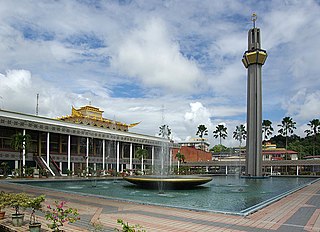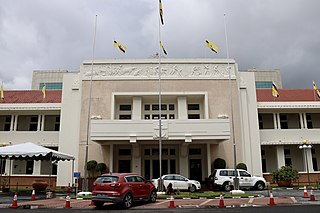
Bandar Seri Begawan (BSB) is the capital and largest city of Brunei. It is officially a municipal area with an area of 100.36 square kilometres (38.75 sq mi) and an estimated population of 100,700 as of 2007. It is part of Brunei–Muara District, the smallest yet most populous district which is home to over 70 per cent of the country's population. It is the country's largest urban centre and nominally the country's only city. The capital is home to Brunei's seat of government, as well as a commercial and cultural centre. It was formerly known as Brunei Town until it was renamed in 1970 in honour of Omar Ali Saifuddien III, the 28th Sultan of Brunei and the father of Sultan Hassanal Bolkiah.

Muhammad Jamalul Alam II was the 26th Sultan of Brunei from 1906 until his death in 1924. He was succeeded by his eldest son Sultan Ahmad Tajuddin.

The Lapau, also known as the Royal Ceremonial Hall, is a ceremonial hall in Bandar Seri Begawan, Brunei. It is where the royal ceremonies, state investiture and some state events are traditionally held. It was the place where the present Sultan of Brunei, Sultan Hassanal Bolkiah, was crowned in 1968.

Pusat Bandar is the city centre of Bandar Seri Begawan, the capital of Brunei. It is home to a number of national landmarks, important government offices, and commercial and financial establishments.

The Malay Technology Museum is a museum in Kota Batu of Bandar Seri Begawan, Brunei. The museum's main objective is to present early Brunei's technical practices, which provide insight into the way of life of the country's inhabitants, who lived in both the water town and on dry ground.

The Pingat Hassanal Bolkiah Sultan is an honorary medal of Brunei. The award is subdivided into two classes: the first class Darjah Pertama and the second class Darjah Kedua.

The Ministry of Religious Affairs (MORA or MoRA; Malay: Kementerian Hal Ehwal Ugama, KHEU) is a cabinet-level ministry in the government of Brunei which is responsible for the propagation of Islam and its upholding as the state religion, as well as oversees the Islamic religious education in the country. It is currently led by a minister and a deputy minister, whereby the incumbents are Badaruddin Othman and Pengiran Mohammad Tashim respectively. The ministry is headquartered in Bandar Seri Begawan.

The Royal Mausoleum in Batu Satu, Bandar Seri Begawan, is a significant historical and cultural landmark in Brunei. Located along the Brunei River, it lies beyond Kampong Ayer and on the route from Bandar Seri Begawan to the Istana Nurul Iman. This site serves as the final resting place for several Bruneian sultans and members of the royal family, with Sultan Omar Ali Saifuddin I, who died in 1795, being the first monarch interred here.

Pengiran Anak Mohamed Alam was a nobleman, magistrate, and politician who served as the fourth Speaker of the Legislative Council from 1971 to 1974, and as the Chief of Adat Istiadat Negara from 1954 to 1981. A member of the Bruneian royal family, he was the father of Pengiran Anak Saleha, the queen consort of Sultan Hassanal Bolkiah. He was also the maternal grandfather of Al-Muhtadee Billah, the Crown Prince of Brunei.

The orders, decorations, and medals of Brunei consist of Bintang-Bintang Kebesaran and Pingat-Pingat Kehormatan. Both are awarded by the Sultan of Brunei on the basis of merit, especially on the contributions to the country. The investiture of some of the state decorations also include the conferment of titles, whereby they become part of the awardees' personal names in official correspondence or when mentioned in formal media in the country. The decorations and medals are under the responsibility of Jabatan Adat Istiadat Negara, a government department under the Prime Minister's Office, which also oversees Bruneian royal traditions and protocol.

The Istana Darussalam is the former residence of Omar Ali Saifuddien III and birthplace of Sultan of Brunei, Hassanal Bolkiah. The palace is located at Jalan Darussalam, Kampong Sumbiling Lama, Brunei–Muara District, Brunei. The building has become a tourist attraction and currently under the protection of the Antiquities and Treasure Trove Act of the Museums Department.

The Secretariat Building or formerly known as the Brunei Government Offices and Government Secretariat Building is the oldest government structure that serves the State Secretariat of Brunei or the seat of government. The building is located at Jalan Elizabeth II, Bandar Seri Begawan, Brunei-Muara District, Brunei. The building is currently under the protection of the Antiquities and Treasure Trove Act of the Museums Department.

Mohammad Abbas Al-Sufri bin Haji Ibrahim was an aristocrat, civil servant and courtier from Brunei who previously served as the acting personal secretary to Sultan Omar Ali Saifuddien III. He had a career in the government service of Brunei, in which he held a number of important positions such as being a member of the Privy Council of Brunei from 1972 to 2014.

Pengiran Muhammad Ali bin Pengiran Haji Muhammad Daud, commonly known as Pengiran Ali, was a Bruneian nobleman, teacher, and politician. He served as the first Deputy Menteri Besar from 1962 to 1965 and was a member of the Legislative, Executive, and Privy Councils. Pengiran Ali played a pivotal role in Brunei's history, particularly during the 1950s and 1960s. He was the first of the "three M's" feared by the British government, alongside Pengiran Muhammad Yusuf and Marsal Maun. He was also the father-in-law of Princess Amal Nasibah, daughter of Sultan Omar Ali Saifuddien III.

The Jabatan Adat Istiadat Negara is a government department under the Prime Minister's Office that functions to guarantee the constant maintenance of Royal Customs. It has been translated literally as the Office of State Customs, the Department of the State Customs or the State Department of Customs and Traditions, even though it does not have an English name. In order to guarantee that the practice and implementation, particularly the Istiadat Diraja, are always in accordance with the philosophy of Melayu Islam Beraja, preaching and teaching the public through lectures, briefings, and workshops on Adat Istiadat (Customs) are regularly held.

Pengiran Abu Bakar bin Pengiran Anak Mohd Salleh was a Bruneian nobleman, civil servant, and politician. He served as the first Speaker of the Legislative Council when it held its inaugural session on 21 October 1959. In addition to his role as speaker, he was appointed as a member of both the Privy Council and the Executive Council, playing a significant part in Brunei's governance during a crucial period in the nation's history.

Abu Bakar bin Jambol (1897–1976) was a Bruneian aristocrat, civil servant and community leader of Tutong descent. He served as a member of the Tujuh Serangkai committee from 1953 to 1954, tasked with gathering public opinions on the proposed constitution of Brunei from both rural and urban communities. The committee produced an extensive report and provided valuable guidance to Sultan Omar Ali Saifuddien III during the drafting process.

Muhammad Yusof bin Muhammad Husain (1906–1975) was an aristocrat and civil servant from Brunei. Between 1953 and 1954, he served as a member of the Tujuh Serangkai committee, tasked with gathering feedback from both urban and rural communities on the proposed Bruneian constitution. During the drafting process, the committee provided Sultan Omar Ali Saifuddien III with invaluable advice and produced a comprehensive report.

Kampong Sumbiling Lama is a neighbourhood in Kampong Ayer, the riverine stilt settlement in Bandar Seri Begawan, the capital of Brunei. It was officially a village subdivision under Sungai Kedayan, a mukim (subdistrict) of Brunei–Muara District. The village's name originated from the division of Kampong Sumbiling into two sections, one of which became Kampong Sumbiling Baru.

Judin bin Haji Asar is a Bruneian aristocrat and civil servant who served as the clerk of the Legislative Council of Brunei (LegCo) from 2004 to 2024.



























